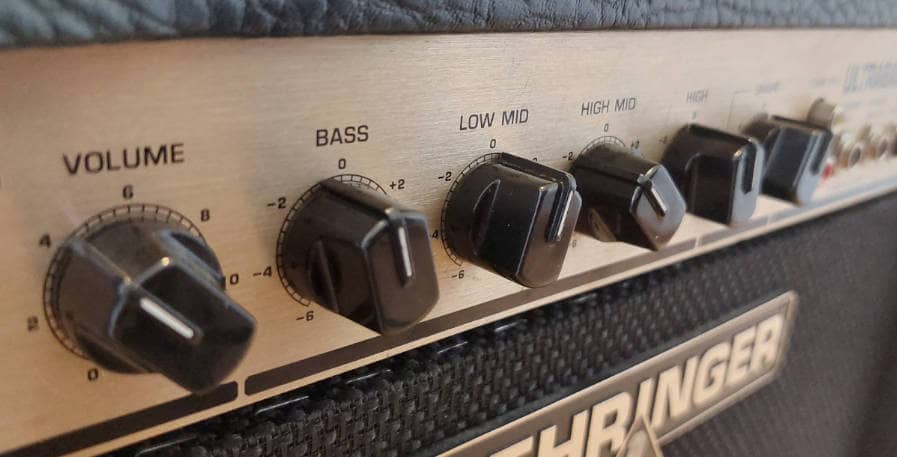Amp settings can make or break your bass tone.
On one hand, bass amp settings can be used to greatly enhance your tone, and make it more fitting for your band, genre, and style. On the other hand, they can also make your tone overly roomy and deep, or too hollow and powerless.
After 15 years of playing bass I`ve learned how to use, and how not to use my amp through trial and error. Thus, by sharing what I`ve learned along the way, my goal is that you won`t have to learn things the hard way like I did.
I will show you the basics of what each knob on your bass does, and how to use them. Then, I`ll cover some common issues you will run into when it comes to amp settings, and how setting your tone differs when playing alone and with a band.
Lastly, I`ll show you how to set your tone depending on what genre you play. This will give you a good starting point for playing any type of music and for tweaking your tone to fit your playstyle.
Bass Amp EQ
The main way bass amps are used to change the tone of your instrument is through equalization, or EQ for short. Equalization changes the tone by increasing or decreasing how well certain frequencies can be heard in the output signal
Bass amps generally have 3 or 4 knobs that let you adjust EQ. Knowing how to use these knobs to get the type of tone you want is a crucial and important skill as a bass player.
Thus, let`s start by looking at what each of these knobs does, and how they can impact the tone of your bass.
Bass (Low-End)
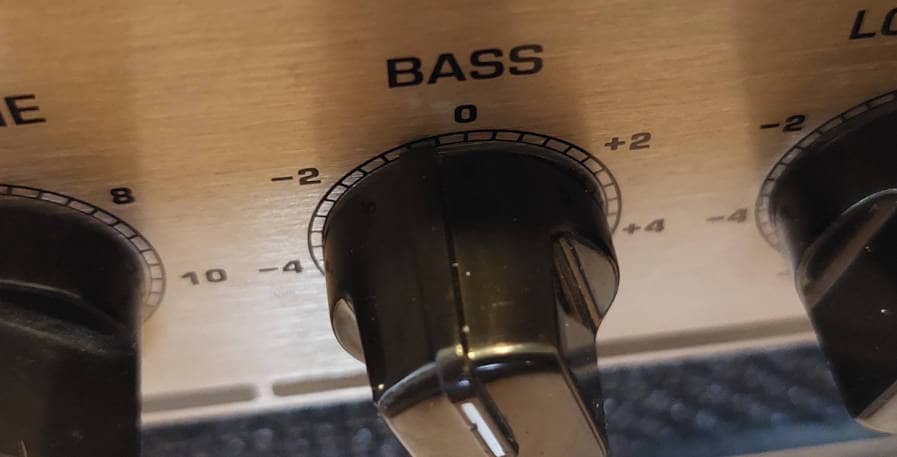
Turn up the bass to sound:
- Deeper
- Boomier
- Muddier
- Fuller
- Bulkier
Turn down the bass to sound:
- Clearer
- Thinner
- Colder
As a complete beginner, I found that turning up the low-end worked great for achieving a heavier and bulkier bass tone. This also made for a less well-rounded sound and one that didn`t work great when I joined my first band.
Thus, for playing the bass alone, turning the low-end up can work great for a solo tone. This is because it helps the tone fill up the room, and prevents the bass from sounding too weak or squeaky.
However, when playing with other people, too much bass can make your instrument sound boomy in the mix. It also makes the bass guitar more likely to drown out the sound of the bass drum. Too much low-end also make it hard for the bass to be heard among the other instruments due to its lack of growl and sharpness.
Thus, while turning up the low-end is an effective way to achieve a fuller sound, too much of it can make your tone muddy and one-dimensional. It can also make your bass do more harm than good, when playing with other people.
Low-Mid
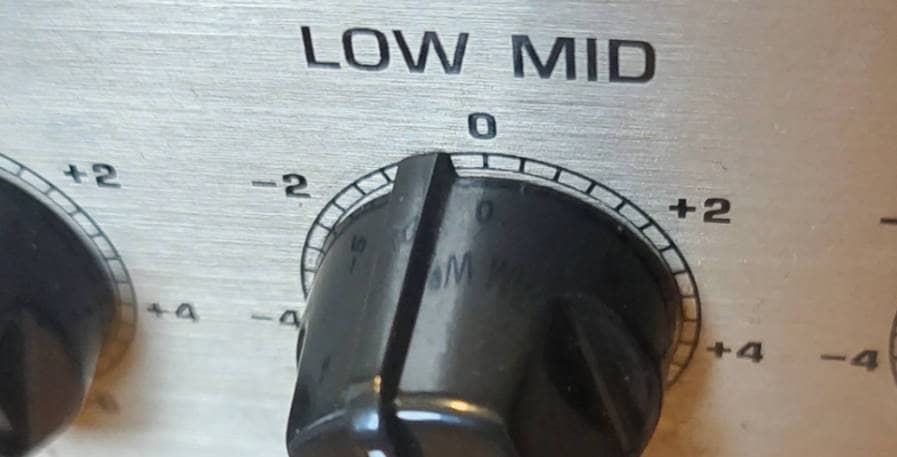
Turn up the low-mids to sound:
- Pronounced
- Well-rounded
- Growlier
Turn down the low-mids to sound:
- Tighter
- More consistent
Turning down the mids diminishes how well your articulation of each individual note can be heard. As a result, your playing can sound more cohesive and tight, and it sounds less bad to play a note too hard or too soft.
On the other hand, this can also remove some of the human element of your playing. With the mids turned down, it becomes harder to add expression and make your lines sound dynamic. This can result in a tone that feels overly clean or robotic.
By turning the low-mids up, you get a tone that retains some low-end, and makes the bass better at cutting through a mix. It also makes for a growlier tone that has some punch to it. Thus, you generally want to avoid dialing down the low-mids when playing aggressive songs.
High-Mid
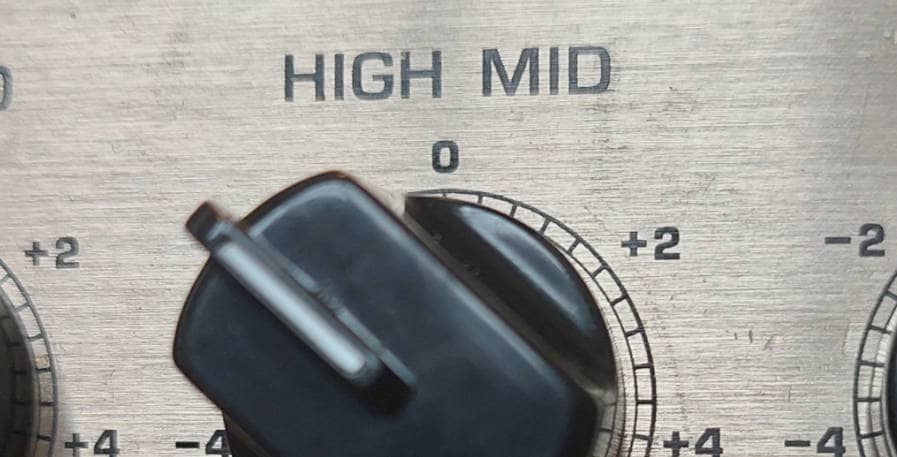
Turn up the high-mids to sound:
- Thicker
- Well-rounded
- Clearer
- More pronounced
Turn down the high-mids to sound:
- Tighter
- Darker
Similar to the low-mids, the high-mids are great at making your bass cut through when playing with other people. As these frequencies are further towards the high-end, turning them up is a great way to achieve a thicker tone, without your tone becoming too low-end focused and boomy.
Some amps don`t have a separate knob for high and low mids. Rather, they have a single mids knob.
It`s best to think of low-mids as mids that have some bass characteristics, and of high-mids as mids that have some treble characteristics. Thus, a single mids knob works as comination of the two, while being less defined in the depth of low-mids or the clearness of high-mids.
Treble (High-End)
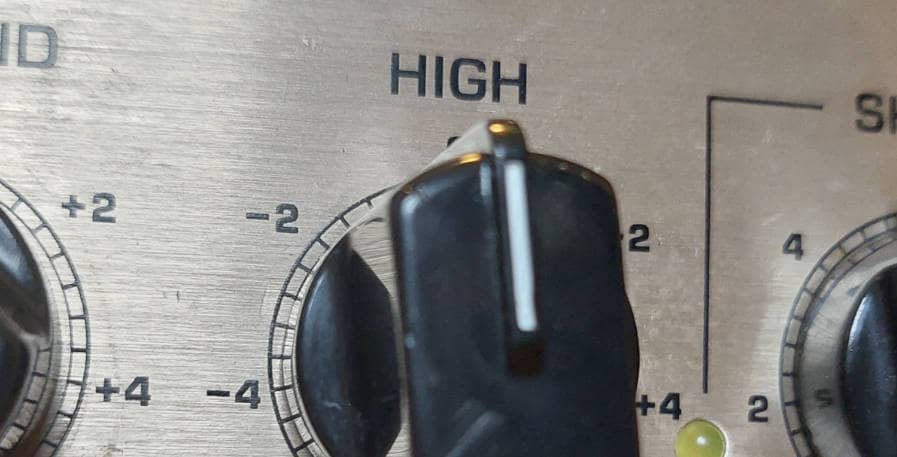
Turn the treble up to sound:
- Sharper
- Brighter
- Scratchier
Turn the Treble down to sound:
- Darker
- Warmer
- Diminish the sound of your pick or your fingers.
Just like the mids, turning up the treble is great for being heard better when playing with a band. Treble differs from the mids in it that it achieves this by making your tone brighter and sharper, rather than making it thicker and more well-rounded.
Without any treble, the bass tends to sound overly musky and downtrodden. This can however be preferable for a more low-end focused and bass-heavy sound, which is common for genres like hip-hop.
On the other hand, slap bassists need to have their slaps and pops sound percussive and zingy. Therefore, they tend to have their treble turned high up. High treble is also common in punk, where it is common for bassists to have a sharp and gritty tone.
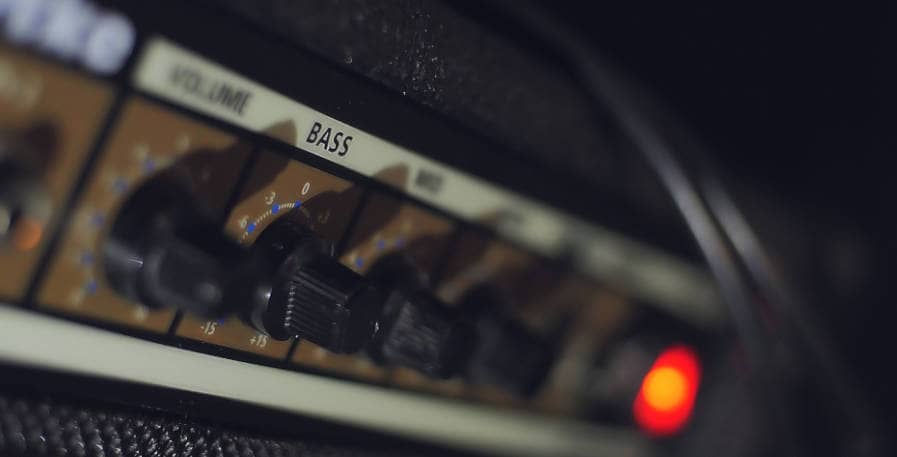
3 Common issues with bass amp settings
As you start using your amp settings to improve your tone, there are some common issues you are likely to run into.
While these often have simple fixes, it can be hard to know where to start if you have not run into them before. Especially so because they can seem like EQ-related issues, without this always having to be the case.
1. How do I make my bass sound deeper?
If you want your bass to sound deeper, turn up the bass frequencies. Then, if the tone is still lacking depth, sparingly turn up the the low-mids.
If you still find that you’re not getting the deep tone you are looking for, play the bass at the bridge pickup for a deeper tone. It is also preferable to play flatwound strings over roundwound strings for this purpose.
2. How do I make my bass sound smoother?
For a clean and smooth bass tone, dial down the treble. Preferably, avoid turning down the mids, and do so sparingly if you find that you still need to remove some high-end.
If your tone still isn`t smooth enough, the issue is likely related to your technique, or the setup of the bass. Try playing the bass with a softer touch and record yourself to check whether unwanted strings are ringing out. I also recommend checking if your bass is in need of a setup.
3. How do I prevent my bass tone from sounding all over the place?
A common beginning mistake with bass amp EQ is to boost frequencies rather than cut them. While boosting works, it can also quickly result in an over-the-top tone that sounds a bit all over the place.
Also, make slight adjustments to the EQ knobs rather than big ones. Slight adjustments have a much bigger impact on your tone than they can seem to at first. This is especially noticble when playing with other people, as your EQ impacts the sound of every instrument in the band.
Most importantly, it is perfectly fine to leave the EQ knobs untouched. Setting every knob at neutral makes for a safe and versatile tone that works well for playing solo and with a band. Thus, while EQ can greatly enhance your tone, I advise against tweaking the knobs just for the sake of doing so.
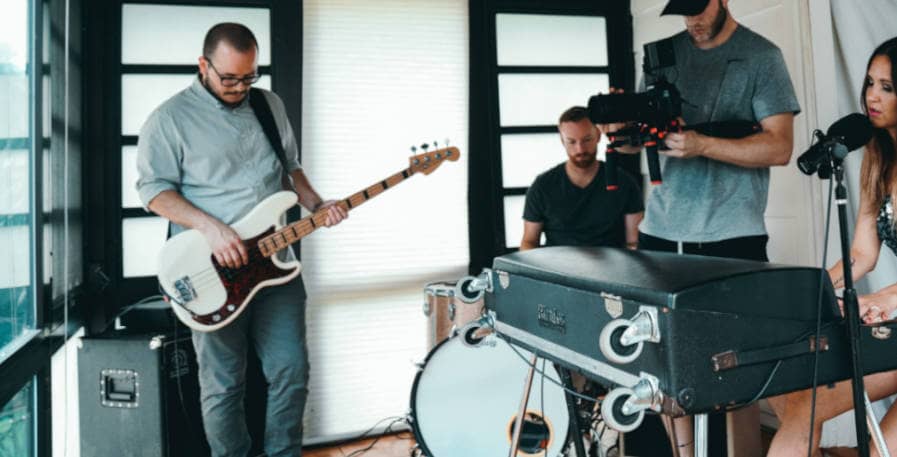
Bass Amp settings with a band
Even if a bass tone sounds perfect on its own, it might not sound good when playing with others.
This is because instruments partly play at the same frequency ranges. When two instruments are EQd to sound clearer at a certain range, they will be harder to distinguish and clash with one another. The band will also cover a narrower range of frequencies overall, which results in the band sounding hollow.
While it is possible for the bass to clash with any instrument in this way, there are two main ones to watch out for: The guitar, and the bass drum.
If the bass and guitar amps are boosted at the same frequencies they blend together and become less defined:
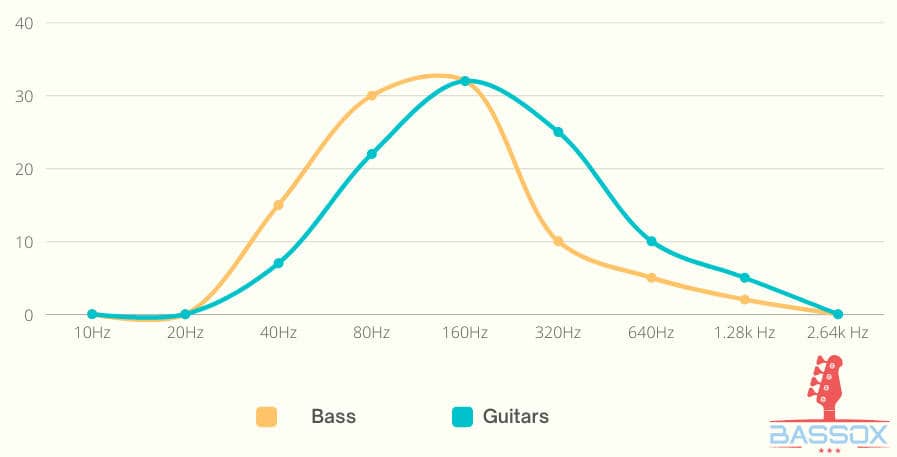
On the other hand, when the bass and guitars are EQd to cover different parts of the frequency spectrum, they are easier to distinguish.
They will also cover a wider range of frequencies, which results in a fuller and more cohesive sound:
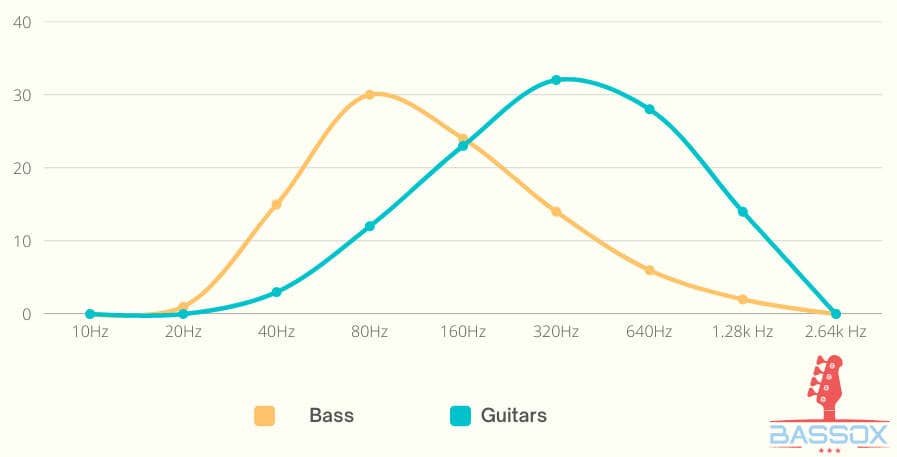
This is achieved by working with your guitarists to find tones that works well together.
Some ways this could play out is that the guitars turn down their bass frequencies. This way the guitars will have a thinner sound, but a meaty bass tone can fill the low-end that the guitar lacks.
Another scenario is that you need to turn up the mids on the bass when you notice your bass drowning out in the mix. In turn, the guitars might then need to turn up their treble or low-end to allow more room for the bass in the mid-range.
As for the bass drum, it is more so up to you as a bass player to set your tone to work well with it.
While this takes some experimentation to do well, boosting the low-mids (or mids), and cutting lows is a great place to start. This lets you retain some of the punch in your tone, without clashing with the fundamental frequencies of the kick.
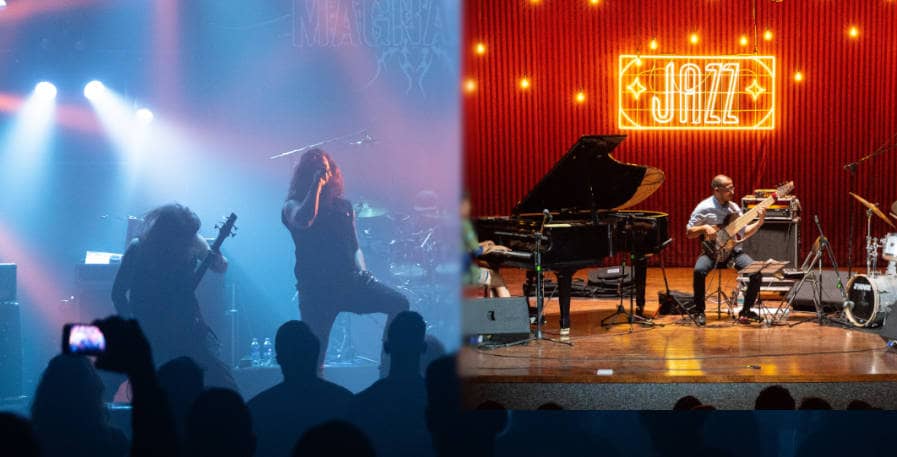
Genres
What genre of music you play has a major impact on how you should set your bass amp. This is because the role of the bass guitar differs greatly between genres.
To get a better feel for this. Here are some basic presets for the most common genres of music. These will give you an idea of what the role of the bass is in each genre, and how to fill that role.
The presets are not set in stone rules for how to set your EQ. Rather, they serve as a general starting point to ensure you get always have a tone that fits with the style of music you play.
Bass amp settings for metal
EQ and amp settings for metal bassists can be tricky. This is because metal bass sounds vastly different when playing alone, and when playing with other people.
A common beginner mistake is to use too much low-end when playing with a band. While this can seemingly make your tone heavier, it often results in the bass not being prominent enough in the mid and high range to be heard among distorted guitars.
Thus, playing with the low-end turned up can make sense for solo practice. In a band though, it will generally work best to turn it down slightly. For the rest of the knobs, setting them at 5-6 will generally work well. If you still struggle to be heard among the guitars, turn up the high-mids.
| Bass | Low-Mids | High-Mids | Treble: | |
| Solo Metal Tone | 7 | 6 | 5 | 5 |
| Metal Tone In a Band | 4 | 6 | 6 | 5 |
Bass amp settings for funk
A common way to set the tone for playing bass in a funk band is with “Smiley Face EQ”. It gets this name because the bass and treble are turned up high and the mids are turned down. When using a mixing board, this results in the dials looking like a smile.
This will result in a funk tone that is suitable when slapping the bass.
If you find that this tone sounds too thin, or is not audible enough, you can elect to turn up the mids. By lowering the low-end slightly too, this will result in a tone that cuts better through guitars and sounds punchier.
| Bass | Low-Mids | High-Mids | Treble: | |
| General Funk Tone | 8 | 3 | 3 | 8 |
| Punchy Funk Tone | 6 | 4 | 6 | 7 |
Bass amp settings for rock
A common way to set the EQ on a bass for rock is by turning up the bass and treble and turning down the mids.
This makes for a deep and heavy tone, that still has some sharpness and clarity to it. The upside of this is that you get a big and fat tone that works great for rock, and fills in the low-end while packing some high-end punch.
The downside is that the lack of mids muddy down the definition of your tone, and makes it harder to hear what you are playing.
Many rock bassists go for this type of tone, and it can work incredibly well despite this. However, for melodic rock bassists that want every note to cut through the mix, it is preferable to put more emphasis on the mids.
For example, to get a Geddy Lee-type bass tone, turn down the bass, and turn up the mids and treble instead.
| Bass | Low-Mids | High-Mids | Treble: | |
| General Rock Tone | 6 | 4 | 4 | 6 |
| Cutting Rock Tone | 4 | 5 | 6 | 7 |
Bass amp settings for jazz
For a general jazz tone, it`s best to boost your mids slightly.
Jazz is a genre where your articulation makes a big difference in the swing and groove of a song. With the mids boosted, the feel and dynamics you add to your playing will be more noticeable. As a result, your tone will fit most forms of jazz.
An alternative is also to opt for a musky and deep tone that is more resemblant of the double bass. This type of tone is poorer for adding swing and feel to the song. The upside is that it makes the bassline sound fuller, which works especially well for deep walking basslines.
| Bass | Low-Mids | High-Mids | Treble: | |
| General Jazz Tone | 4 | 6 | 6 | 4 |
| Musky Deep Jazz Tone | 6 | 5 | 5 | 4 |
Bass amp settings for punk
There is a lot that goes into getting a gritty punk bass tone. However, through their playstyle, string choice, and amp settings, punk bassists are generally looking for one thing: brightness.
Thus, if you are looking for a sharp modern punk tone, turn the treble way up. If you have a separate knob for low and high mids, put more emphasis on the highs. This will help you achieve the sharp and bright sound that has grown to define the genre.
For a more old-school punk tone, it is preferable to put more emphasis on the low-end instead.
This tone is poorer at cutting through the mix and does not have the same degree of sharpness. On the other hand, it does much better at filling in the low end and sounds tigther in the mix.
| Bass | Low-Mids | High-Mids | Treble | |
| Gritty Modern Punk Tone | 4 | 6 | 8 | 8 |
| Old-School Punk Tone | 8 | 3 | 4 | 5 |
Bass amp settings for hip-hop
Playing hip-hop on the bass requires control and versatility. Thus, your playstyle and articulation can play as big of a part in your tone as your amp settings.
The bass in hip-hop often has to fill up a lot of space, without sounding intrusive to the other instruments or the vocals. Therefore, you generally want a low-end focused sound with low treble when playing hip-hop.
This will ensure that you fill out the mix nicely and that songs don`t sound too hollow. It also makes for a smooth and bass-heavy sound, which is common in the genre.
| Bass | Low-Mids | High-Mids: | Treble: |
| 8 | 4 | 3 | 3 |
Bass amp settings for pop
Similar to hip-hop, a pop bass tone generally has a good bit of low-end and is less top-end heavy.
As for the rest of the EQ, getting a good pop tone can be a bit tricky. This is because you generally don`t want the bass to cut too much through the other instruments. At the same time, it is also preferable to retain some sharpness in the tone.
To best achieve this, turn down the mids, but keep the treble neutral. This will serve as a great starting point for a modern pop sound.
As it is a very diverse genre, you might need to adjust the EQ from there to fit a particular song or band. If you feel the need to do so, it is a best practice to not dial the mids too high, and always be conscious of when they start making your tone sound intrusive to the mix as a whole.
| Bass | Low-Mids | High-Mids: | Treble: |
| 7 | 3 | 3 | 5 |
Conclusion
There are many small nuances to bass amp settings that all impact your tone. However, keeping your knobs at neutral, or going with a preset that fits your genre is a great place to start.
There are also many other things that go into your bass tone than amp settings.
What bass you play, how you play it, and the thickness of the strings all have a big impact on your tone. Thus, always keep in mind that there are limitations to how much your amp can do for you.
Most importantly, I recommend using what you have learned above to experiment. While the genre-specific presets can serve as a great starting point, only you can find out what type of tone perfectly encapsulates your style.
As long as you make small adjustments at a time, and are aware of what the different EQ knobs do, you will be off to a better start than I had. Thus, I hope that my beginner mistakes were good for something, and that this guide helped you get a better understanding of how you can use your amp to enhance your bass tone.

